airbag off KIA Sephia 2006 2.G Owner's Manual
[x] Cancel search | Manufacturer: KIA, Model Year: 2006, Model line: Sephia, Model: KIA Sephia 2006 2.GPages: 273, PDF Size: 2.83 MB
Page 41 of 273
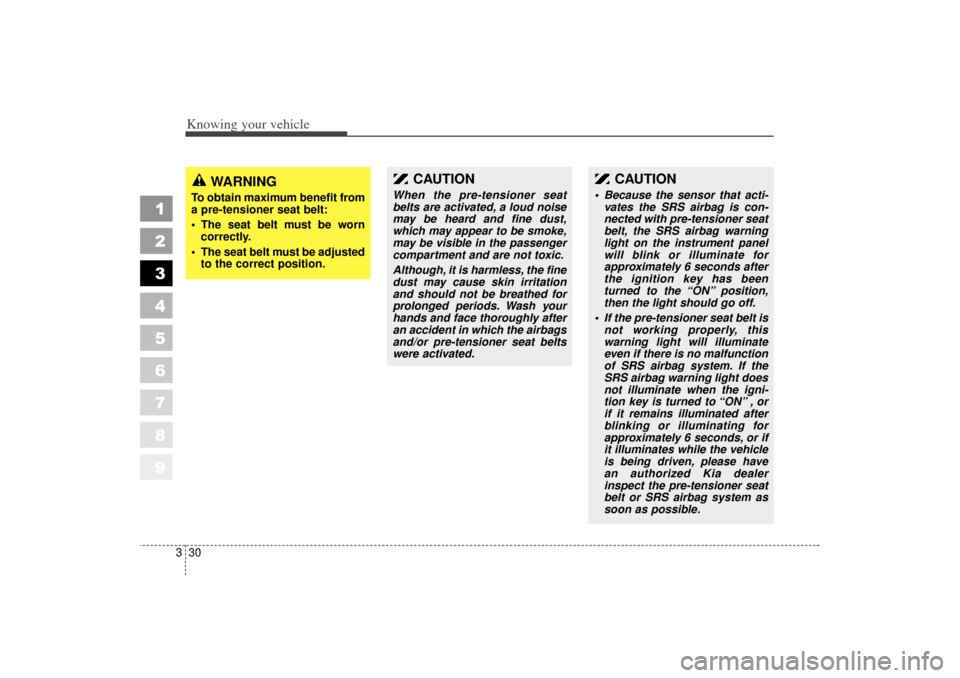
Knowing your vehicle30
3
1
2
3
4
5
6
7
8
9
WARNING
To obtain maximum benefit from
a pre-tensioner seat belt:
The seat belt must be worn
correctly.
The seat belt must be adjusted to the correct position.
CAUTION
When the pre-tensioner seat
belts are activated, a loud noise
may be heard and fine dust,
which may appear to be smoke,
may be visible in the passenger
compartment and are not toxic.
Although, it is harmless, the fine
dust may cause skin irritation
and should not be breathed for
prolonged periods. Wash your
hands and face thoroughly after
an accident in which the airbags
and/or pre-tensioner seat belts
were activated.
CAUTION
Because the sensor that acti-vates the SRS airbag is con-
nected with pre-tensioner seat
belt, the SRS airbag warning
light on the instrument panel
will blink or illuminate for
approximately 6 seconds after
the ignition key has been
turned to the “ON” position,
then the light should go off.
If the pre-tensioner seat belt is not working properly, this
warning light will illuminate
even if there is no malfunction
of SRS airbag system. If the
SRS airbag warning light does
not illuminate when the igni-
tion key is turned to “ON” , or
if it remains illuminated after
blinking or illuminating for
approximately 6 seconds, or if
it illuminates while the vehicle
is being driven, please have
an authorized Kia dealer
inspect the pre-tensioner seat
belt or SRS airbag system as
soon as possible.
LD CAN (ENG) new 3-1~.qxd 7/29/05 10:28 AM Page 30
Page 68 of 273
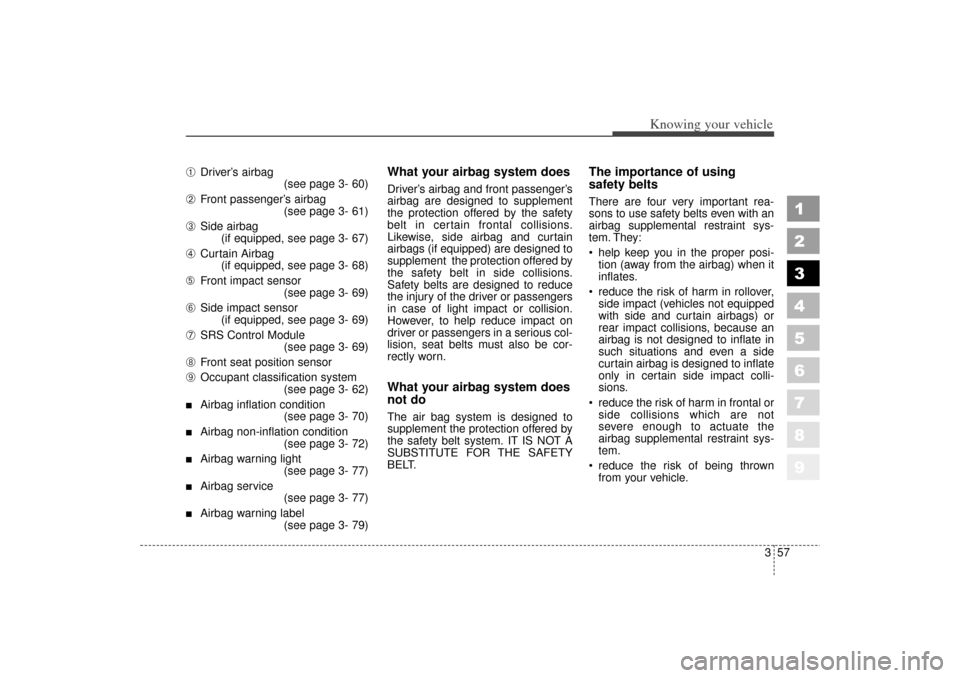
357
1
2
3
4
5
6
7
8
9
Knowing your vehicle
➀
Driver’s airbag
(see page 3- 60)
➁
Front passenger’ s airbag
(see page 3- 61)
➂
Side airbag (if equipped, see page 3- 67)
➃
Curtain Airbag(if equipped, see page 3- 68)
➄ Front impact sensor
(see page 3- 69)
\b
Side impact sensor(if equipped, see page 3- 69)
➆
SRS Control Module (see page 3- 69)
➇
Front seat position sensor
➈
Occupant classification system(see page 3- 62)
Airbag inflation condition(see page 3- 70)
Airbag non-inflation condition(see page 3- 72)
Airbag warning light(see page 3- 77)
Airbag service(see page 3- 77)
Airbag warning label(see page 3- 79)
What your airbag system doesDriver’s airbag and front passenger’ s
airbag are designed to supplement
the protection offered by the safety
belt in certain frontal collisions.
Likewise, side airbag and curtain
airbags (if equipped) are designed to
supplement the protection offered by
the safety belt in side collisions.
Safety belts are designed to reduce
the injury of the driver or passengers
in case of light impact or collision.
However, to help reduce impact on
driver or passengers in a serious col-
lision, seat belts must also be cor-
rectly worn.What your airbag system does
not doThe air bag system is designed to
supplement the protection offered by
the safety belt system. IT IS NOT A
SUBSTITUTE FOR THE SAFETY
BELT.
The importance of using
safety beltsThere are four very important rea-
sons to use safety belts even with an
airbag supplemental restraint sys-
tem. They:
help keep you in the proper posi-
tion (away from the airbag) when it
inflates.
reduce the risk of harm in rollover,
side impact (vehicles not equipped
with side and curtain airbags) or
rear impact collisions, because an
airbag is not designed to inflate in
such situations and even a side
curtain airbag is designed to inflate
only in certain side impact colli-
sions.
reduce the risk of harm in frontal or
side collisions which are not
severe enough to actuate the
airbag supplemental restraint sys-
tem.
reduce the risk of being thrown
from your vehicle.
LD CAN (ENG) new 3-1~.qxd 7/29/05 10:28 AM Page 57
Page 70 of 273
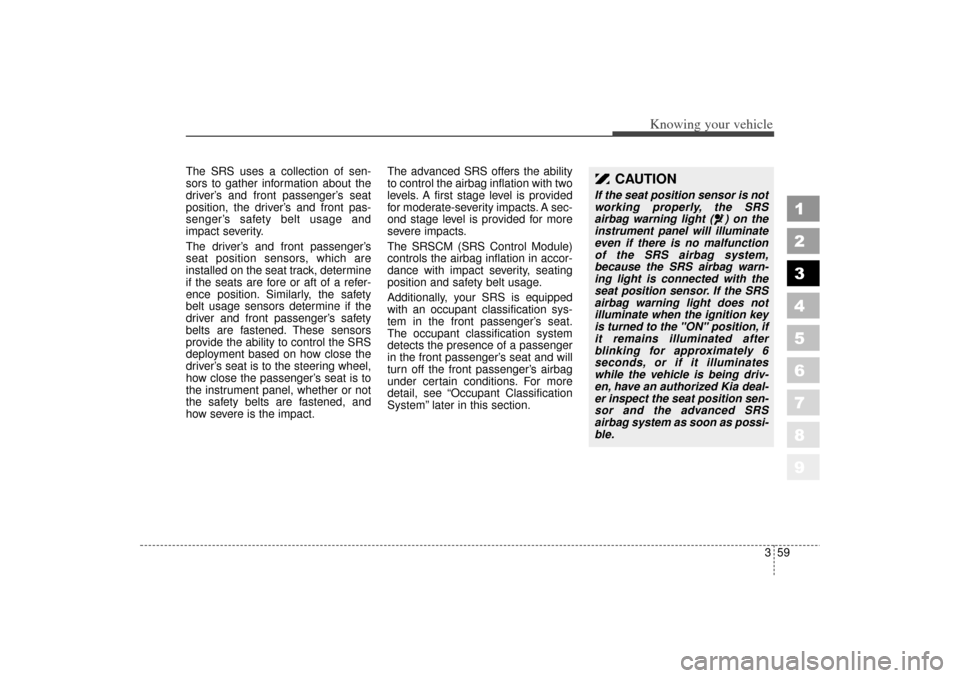
359
1
2
3
4
5
6
7
8
9
Knowing your vehicle
The SRS uses a collection of sen-
sors to gather information about the
driver’s and front passenger’ s seat
position, the driver’ s and front pas-
senger’ s safety belt usage and
impact severity.
The driver’ s and front passenger’ s
seat position sensors, which are
installed on the seat track, determine
if the seats are fore or aft of a refer-
ence position. Similarly, the safety
belt usage sensors determine if the
driver and front passenger’ s safety
belts are fastened. These sensors
provide the ability to control the SRS
deployment based on how close the
driver’ s seat is to the steering wheel,
how close the passenger’ s seat is to
the instrument panel, whether or not
the safety belts are fastened, and
how severe is the impact. The advanced SRS offers the ability
to control the airbag inflation with two
levels. A first stage level is provided
for moderate-severity impacts. A sec-
ond stage level is provided for more
severe impacts.
The SRSCM (SRS Control Module)
controls the airbag inflation in accor-
dance with impact severity, seating
position and safety belt usage.
Additionally, your SRS is equipped
with an occupant classification sys-
tem in the front passenger’
s seat.
The occupant classification system
detects the presence of a passenger
in the front passenger’ s seat and will
turn off the front passenger ’s airbag
under certain conditions. For more
detail, see “Occupant Classification
System” later in this section.
CAUTION
If the seat position sensor is not
working properly, the SRS
airbag warning light ( ) on the
instrument panel will illuminate
even if there is no malfunction
of the SRS airbag system,
because the SRS airbag warn-
ing light is connected with the
seat position sensor. If the SRS
airbag warning light does not
illuminate when the ignition key
is turned to the "ON" position, if
it remains illuminated after
blinking for approximately 6
seconds, or if it illuminates
while the vehicle is being driv-
en, have an authorized Kia deal-
er inspect the seat position sen-
sor and the advanced SRS
airbag system as soon as possi-
ble.
LD CAN (ENG) new 3-1~.qxd 7/29/05 10:28 AM Page 59
Page 71 of 273
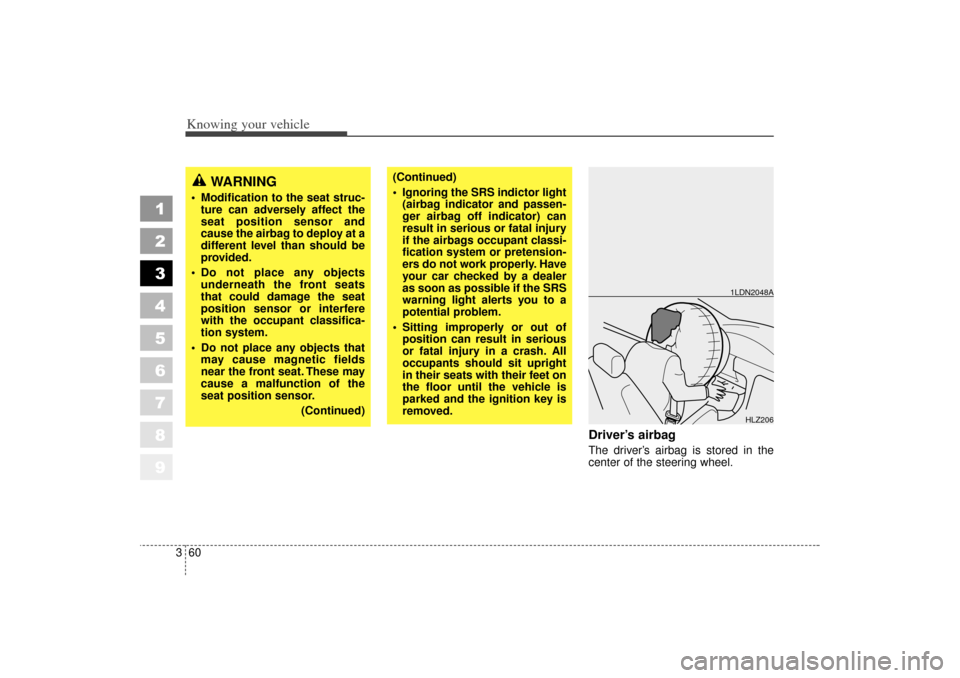
Knowing your vehicle60
3
1
2
3
4
5
6
7
8
9
Driver’s airbagThe driver’ s airbag is stored in the
center of the steering wheel.
WARNING
Modification to the seat struc- ture can adversely affect the
seat position sensor and
cause the airbag to deploy at a
different level than should be
provided.
Do not place any objects underneath the front seats
that could damage the seat
position sensor or interfere
with the occupant classifica-
tion system.
Do not place any objects that may cause magnetic fields
near the front seat. These may
cause a malfunction of the
seat position sensor.
(Continued)
(Continued)
Ignoring the SRS indictor light(airbag indicator and passen-
ger airbag off indicator) can
result in serious or fatal injury
if the airbags occupant classi-
fication system or pretension-
ers do not work properly. Have
your car checked by a dealer
as soon as possible if the SRS
warning light alerts you to a
potential problem.
Sitting improperly or out of position can result in serious
or fatal injury in a crash. All
occupants should sit upright
in their seats with their feet on
the floor until the vehicle is
parked and the ignition key is
removed.
HLZ206
1LDN2048A
LD CAN (ENG) new 3-1~.qxd 7/29/05 10:28 AM Page 60
Page 72 of 273
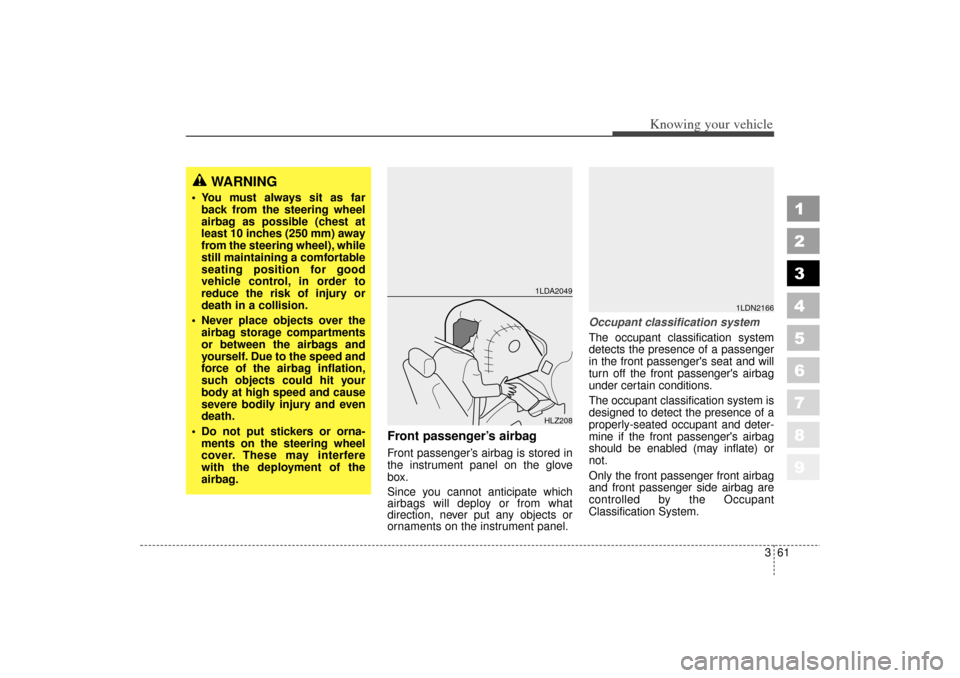
361
1
2
3
4
5
6
7
8
9
Knowing your vehicle
Front passenger’s airbagFront passenger’s airbag is stored in
the instrument panel on the glove
box.
Since you cannot anticipate which
airbags will deploy or from what
direction, never put any objects or
ornaments on the instrument panel. Occupant classification system
The occupant classification system
detects the presence of a passenger
in the front passenger's seat and will
turn off the front passenger's airbag
under certain conditions.
The occupant classification system is
designed to detect the presence of a
properly-seated occupant and deter-
mine if the front passenger's airbag
should be enabled (may inflate) or
not.
Only the front passenger front airbag
and front passenger side airbag are
controlled by the Occupant
Classification System.
WARNING
You must always sit as far
back from the steering wheel
airbag as possible (chest at
least 10 inches (250 mm) away
from the steering wheel), while
still maintaining a comfortable
seating position for good
vehicle control, in order to
reduce the risk of injury or
death in a collision.
Never place objects over the airbag storage compartments
or between the airbags and
yourself. Due to the speed and
force of the airbag inflation,
such objects could hit your
body at high speed and cause
severe bodily injury and even
death.
Do not put stickers or orna- ments on the steering wheel
cover. These may interfere
with the deployment of the
airbag.
1LDA2049HLZ208
1LDN2166
LD CAN (ENG) new 3-1~.qxd 7/29/05 10:28 AM Page 61
Page 73 of 273

Knowing your vehicle62
3
1
2
3
4
5
6
7
8
9
Main components of occupant
classification system
A detection device located within
the front passenger seat cushion.
Electronic system to determine
whether passenger airbag systems
(both front and side) should be
activated or deactivated.
A warning light located on the
instrument panel which illuminates
the words "PASSENGER AIRBAG
OFF" passenger airbag system is
deactivated.
The instrument panel airbag warn-
ing light is interconnected with the
occupant classification system. If there is no passenger in the front
passenger seat or if the passenger in
the front passenger seat is very light,
(such as a child), the front
PASSEN-
GER AIRBAG OFF indicator may
illuminate.
When this indicator is ON, neither
the front passenger front airbag nor
front passenger side airbag will
deploy in either a side or frontal colli-
sion. Always be sure that you and all vehi-
cle occupants are seated and
restrained properly (sitting upright
with the seat in an upright position,
centered on the seat cushion, with
the person's legs comfortably
extended, feet on the floor, and wear-
ing the safety belt properly) for the
most effective protection by the
airbag and the safety belt.
The OCS may not function proper-
ly if the passenger takes actions
which can defeat the detection sys-
tem. These include:
(1) Failing to sit in an upright posi- tion.
(2) Leaning against the door or cen- ter console.
(3) Sitting towards the sides or the front of the seat.
(4) Putting legs on the dashboard or resting them on other locations
which reduce the passenger
weight on the front seat.
(5) Improperly wearing the safety
belt.
(6) Reclining the seat back.
1LDN2150A
The location of OCS warning indicator
LD CAN (ENG) new 3-1~.qxd 7/29/05 10:28 AM Page 62
Page 74 of 273
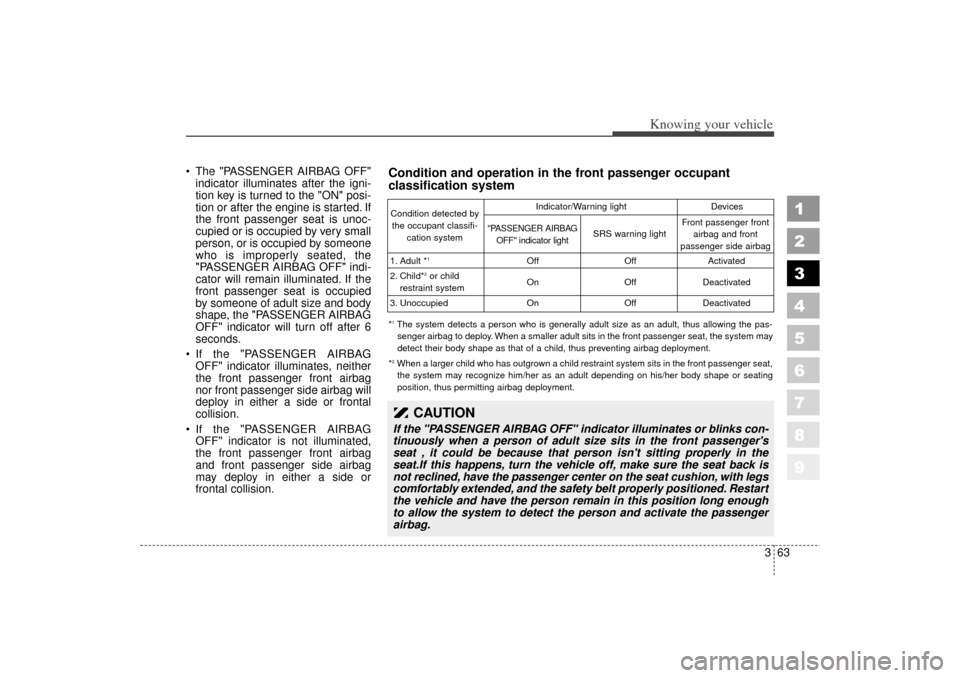
363
1
2
3
4
5
6
7
8
9
Knowing your vehicle
The "PASSENGER AIRBAG OFF"
indicator illuminates after the igni-
tion key is turned to the "ON" posi-
tion or after the engine is started. If
the front passenger seat is unoc-
cupied or is occupied by very small
person, or is occupied by someone
who is improperly seated, the
"PASSENGER AIRBAG OFF" indi-
cator will remain illuminated. If the
front passenger seat is occupied
by someone of adult size and body
shape, the "PASSENGER AIRBAG
OFF" indicator will turn off after 6
seconds.
If the "PASSENGER AIRBAG
OFF" indicator illuminates, neither
the front passenger front airbag
nor front passenger side airbag will
deploy in either a side or frontal
collision.
If the "PASSENGER AIRBAG
OFF" indicator is not illuminated,
the front passenger front airbag
and front passenger side airbag
may deploy in either a side or
frontal collision.
Condition and operation in the front passenger occupant
classification systemCondition detected by
the occupant classifi- cation system
1. Adult *
1
2. Child*
2or child
restraint system
3. Unoccupied Off
On
On Off
Off
OffActivated
Deactivated
Deactivated
"PASSENGER AIRBAG OFF" indicator light
SRS warning light Front passenger front
airbag and front
passenger side airbag
Indicator/Warning light
Devices
*1The system detects a person who is generally adult size as an adult, thus allowing the pas-
senger airbag to deploy. When a smaller adult sits in the front passenger seat, the system may
detect their body shape as that of a child, thus preventing airbag deployment.
*2When a larger child who has outgrown a child restraint system sits in the front passenger seat, the system may recognize him/her as an adult depending on his/her body shape or seating
position, thus permitting airbag deployment.
CAUTION
If the "PASSENGER AIRBAG OFF" indicator illuminates or blinks con-
tinuously when a person of adult size sits in the front passenger's
seat , it could be because that person isn't sitting properly in the
seat.If this happens, turn the vehicle off, make sure the seat back is
not reclined, have the passenger center on the seat cushion, with legs
comfortably extended, and the safety belt properly positioned. Restart
the vehicle and have the person remain in this position long enough
to allow the system to detect the person and activate the passenger
airbag.
LD CAN (ENG) new 3-1~.qxd 7/29/05 10:28 AM Page 63
Page 75 of 273

Knowing your vehicle64
3
1
2
3
4
5
6
7
8
9
(Continued)
If the "PASSENGER AIRBAG
OFF" indicator is illuminated
when the front passenger's
seat is occupied by a person
of adult size who is seated
properly, or if the "PASSEN-
GER AIRBAG OFF" indicator"
is not illuminated when the
front passenger's seat is
unoccupied or occupied by a
very small person, the occu-
pant classification system is
not working properly. Have
your vehicle immediately
inspected by your Kia dealer if
the occupant classification
system is not working proper-
ly.
(Continued)
CAUTION
If the occupant classification
system is not working properly,
the airbag warning light ( ) on
the instrument panel will illumi-
nate. If there is a malfunction of
the occupant classification sys-
tem, the "PASSENGER AIRBAG
OFF" indicator will not illumi-
nate and the front passenger's
airbag will deploy in frontal
crashes even if there is an adult
sized occupant in the front pas-
senger seat. If the SRS airbag
warning light does not illumi-
nate when the ignition key is
turned to "ON" position, if it
remains illuminated after blink-
ing for approximately six sec-
onds, or if it illuminates while
the vehicle is being driven, have
an authorized Kia dealer inspect
the occupant classification sys-
tem with the SRS airbag system
as soon as possible.
WARNING
If the front passenger seat
should be modified for persons
with disabilities that may affect
the operation of the occupant
classification system, contact
an authorized Kia dealer.
WARNING
Even though your vehicle isequipped with the occupant
classification system, do not
install a child restraint system
in the front passenger seat.
The child could be severely
injured or killed if the airbag
deploys. Children are afforded
the most protection in the
event of an accident when
they are restrained by the
proper restraint system in the
rear seat.
(Continued)
LD CAN (ENG) new 3-1~.qxd 7/29/05 10:28 AM Page 64
Page 76 of 273

365
1
2
3
4
5
6
7
8
9
Knowing your vehicle
(Continued)
If a very low weight adult isseated in the front passenger
seat, the occupant classifica-
tion system may or may not
turn off the right front passen-
ger air bag, depending upon
the person's seating position
and body type. Everyone in
your vehicle should wear a
safety belt properly -- whether
or not there is an air bag for
that person.
If the front seat passenger changes their seating position
(for example, by not sitting
upright, by sitting on the edge
of the seat, or by otherwise
being out of position), the
"PASSENGER AIRBAG OFF"
indicator may be turned on,
and the passenger airbag may
not deploy in a collision.
Always be sure to sit properly
in the front passenger seat
and wear the safety belt prop-
erly.
(Continued)
1KMN3661
Do Not Do This:Do Not Do This:
1KMN3662
1KMN36631KMN3664
- Put a heavy load in the frontpassenger seat.
- Excessively recline the front passenger seatback. - Do not sit on the front edge
of the front passenger seat.
- Do not sit towards the side of the front seat, or lean against
the console or door.
(Continued)
(Continued)
Do Not Do This:Do Not Do This:
LD CAN (ENG) new 3-1~.qxd 7/29/05 10:29 AM Page 65
Page 77 of 273
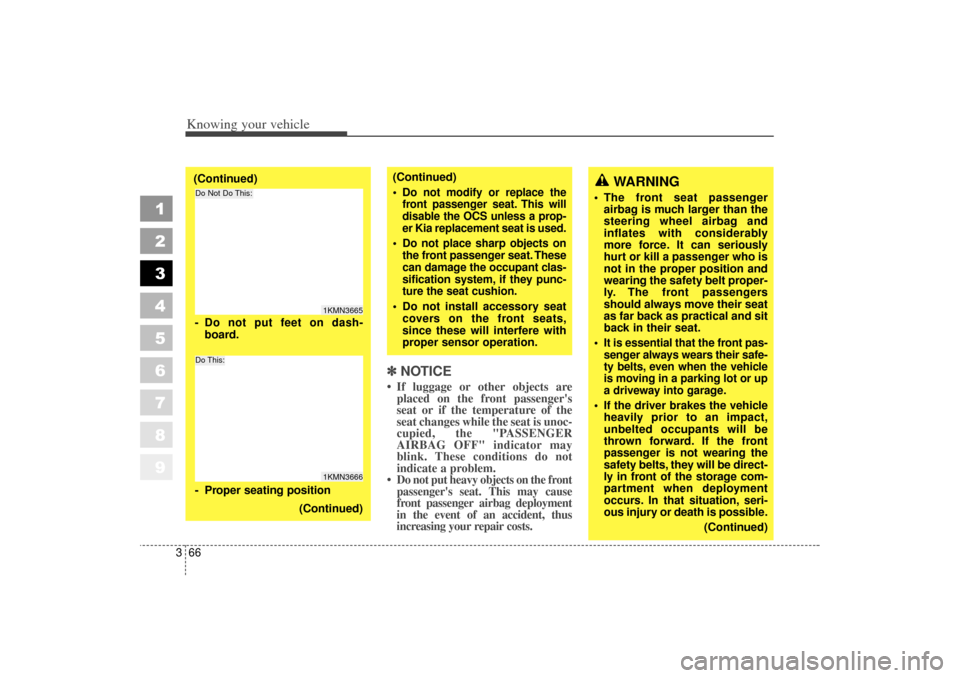
Knowing your vehicle66
3
1
2
3
4
5
6
7
8
9
✽ ✽
NOTICE If luggage or other objects are
placed on the front passenger's
seat or if the temperature of the
seat changes while the seat is unoc-
cupied, the "PASSENGER
AIRBAG OFF" indicator may
blink. These conditions do not
indicate a problem.
Do not put heavy objects on the front
passenger's seat. This may cause
front passenger airbag deployment
in the event of an accident, thus
increasing your repair costs.
1KMN36651KMN3666
- Proper seating position
- Do not put feet on dash-
board.Do Not Do This:Do This:(Continued)
(Continued)
Do not modify or replace the
front passenger seat. This will
disable the OCS unless a prop-
er Kia replacement seat is used.Do not place sharp objects on
the front passenger seat. These
can damage the occupant clas-
sification system, if they punc-
ture the seat cushion. Do not install accessory seatcovers on the front seats,
since these will interfere with
proper sensor operation.
WARNING
The front seat passengerairbag is much larger than the
steering wheel airbag and
inflates with considerably
more force. It can seriously
hurt or kill a passenger who is
not in the proper position and
wearing the safety belt proper-
ly. The front passengers
should always move their seat
as far back as practical and sit
back in their seat.
It is essential that the front pas-
senger always wears their safe-
ty belts, even when the vehicle
is moving in a parking lot or up
a driveway into garage. If the driver brakes the vehicle heavily prior to an impact,
unbelted occupants will be
thrown forward. If the front
passenger is not wearing the
safety belts, they will be direct-
ly in front of the storage com-
partment when deployment
occurs. In that situation, seri-
ous injury or death is possible.
(Continued)
(Continued)
LD CAN (ENG) new 3-1~.qxd 7/29/05 10:29 AM Page 66